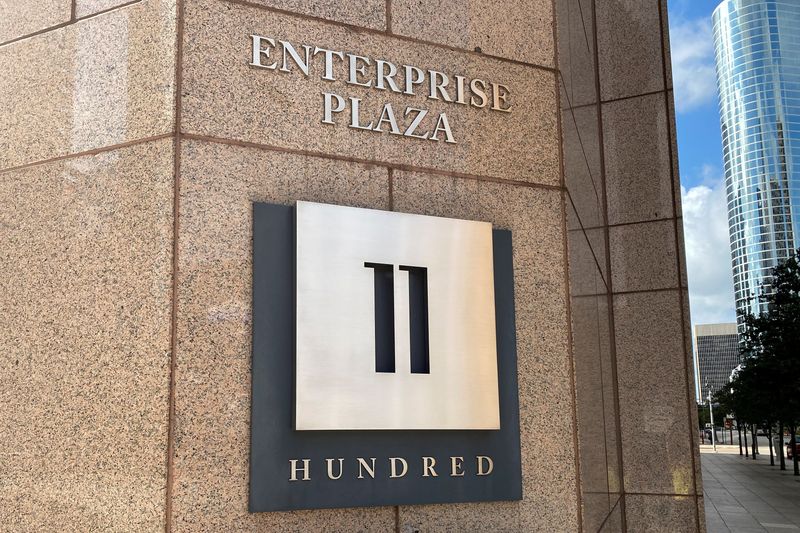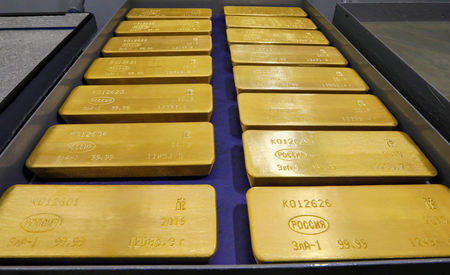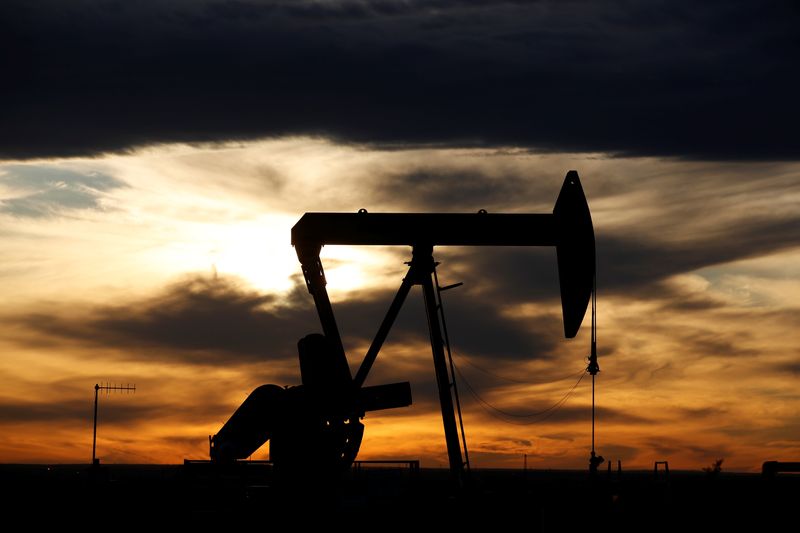Commodities
As shale oil gains slow, deepwater port struggles for customers

By Arathy Somasekhar
HOUSTON (Reuters) – As U.S. shale oil boomed last decade, an oil pipeline company pitched an ambitious multi-billion-dollar export port off the Texas coast to ship domestic crude to buyers in Europe and Asia.
In April, Enterprise Products Partners (NYSE:)’ SPOT became the first project to receive a license from the U.S. maritime regulator for a deepwater port that could load two supertankers, each of which can carry up to 2 million barrels of oil at a time.
But multi-year regulatory delays, a loss of commercial backers and slowing U.S. shale production has left SPOT, or Sea Port Oil Terminal, and its three rival projects without any secured customers, energy industry executives say.
“There are a lot of gray areas right now with export projects,” said Zack Van Everen, an oil analyst at energy investment banker Tudor Pickering Holt & Co.
Enterprise declined to make an executive available for an interview, but said it continues to develop the project.
Shale producers and traders rely on ports to get their oil to market and are balking at the higher-than-expected loading fees for new projects even if they are able to fully load supertankers, executives said.
HIGHER COSTS
SPOT, proposed for a point 30 miles off the Gulf coast in 2019, is the only Texas deepwater project with its government approvals. But its cost has soared to about $3 billion, two industry experts said, from an original estimate of $1.85 billion for Enterprise.
It has no long-term customer contracts, or joint venture partners, stalling a financial green light from the company, sources said. The project, if approved, is currently expected to start up in 2027.
remove ads
.
A customer willing to commit the largest volume is being offered a $1 per barrel rate by Enterprise to load at SPOT oil transferred from its Houston storage terminal, three people familiar the terms said. Clients with smaller loads have been offered an about $1.20 a barrel fee.
That compares with the all-in cost of about 75 cents per barrel to load in Corpus Christi, Texas, the top U.S. oil export port, a source familiar with export operations said.
To sweeten the deal, Enterprise is offering preferential terms for loading schedules, and may bundle some of its other services to make the price more competitive, two of the people said.
Enterprise disputed the fees, but declined to provide the project’s cost and the per barrel terms.
A deepwater port allows customers to load oil directly onto a supertanker, eliminating the additional cost of loading the oil on smaller ships at shallower ports and then transferring the crude from the smaller vessels to larger ones.
But it has lost Chevron (NYSE:) as an early backer because of the regulatory delays to secure a license, and Canadian oil pipeline operator Enbridge (NYSE:) has released its option to take a stake in SPOT, Enterprise said.
Chevron declined to comment on commercial matters.
An Enbridge spokesperson said it views SPOT “as a valuable option for our Canadian heavy crude customers to be able to access the project,” but declined further comment.
LESS NEED FOR DEEPWATER PORTS
U.S. exports of crude rose to a peak of 5.6 million bpd in February 2023, and existing facilities can handle as much as another 1.5 million barrels, though port congestion could limit that number, according to RBN Energy. Russia’s invasion of Ukraine also has shifted global flows with more U.S. vessels going to Europe instead of Asia, which were primarily geared to using supertankers.
remove ads
.
“The short-term dynamic is less need for big ship capacity, which actually fits the current U.S. export capacity a lot better,” Colin Parfitt, Chevron’s vice president of midstream, said in an interview in March.
Changing flows and slowing shale output gains have created uncertainty for shippers. “That’s changed the dynamic a little about how people want these (deepwater ports),” Parfitt said. “If you get one built, it is going to crowd out the others.”
Currently, there is one U.S. offshore port – called the Louisiana Offshore Oil Port – that can fully load supertankers. However it primarily handles oil produced in the Gulf of Mexico and has few pipes that link to the top U.S. shale field, the Permian, in West Texas.
SPOT’s largest target would be moving shale oil, and those output gains have slowed dramatically. U.S production is expected to rise 280,000 barrels per day to 13.21 million bpd this year, according to the U.S. Energy Information Administration. That compared with a one-year gain of 1.6 million bpd in 2018.
Enterprise said this month that it projects growth in and around the Permian basin past 2030.
Consolidation among top shale players, like Exxon Mobil (NYSE:)’s recent purchase of Pioneer Natural Resources (NYSE:), also took away customers for Enterprise and other players, with some of the largest shale drillers already holding long-term contracts with existing export facilities.
Of the three other deepwater port projects along the Texas coast, private-equity backed Sentinel Midstream, oil refiner Phillips 66 (NYSE:) and pipeline operator Energy Transfer (NYSE:) each have sought U.S. approvals for offshore ports. So far, none have received licenses.
remove ads
.
“Between the current dock capacity along the U.S. Gulf Coast, and the most aggressive production projections, it appears that one, at most two,” could proceed, said oil export consultant Brett Hunter of Energy Hunter LLC.
Commodities
Oil prices set for steep weekly losses; payrolls could drive sentiment

Investing.com– Oil prices edged higher Friday, lifting from near seven-week lows, but were headed for steep losses this week as signs of robust U.S. stockpiles and production dashed hopes for tight crude markets in the coming months.
At 08:05 ET (12:05 GMT), rose 0.6% to $84.20 a barrel, while gained 0.6% to $79.44 a barrel.
Crude set for hefty losses this week
Despite these gains, both contracts were still trading close to their weakest levels in seven weeks, and were set to lose between 5% and 6% this week.
An unexpected build in U.S. and data showing increased U.S. production suggested that oil markets were not as tight as traders were initially hoping.
This was coupled with easing fears of supply disruptions in the Middle East, as Israel and Hamas continued negotiations over a potential ceasefire.
Concerns over slowing economic growth – which could eat into demand – also came into play this week, especially after the U.S. Federal Reserve warned that it will keep interest rates higher for longer.
Middling data from top crude importer China also factored into fears of sluggish demand. Business activity in the country was seen slowing in April after a strong start to the year.
Markets were also on edge ahead of the release of key U.S. data later in the day, which is likely to factor into the outlook for interest rates.
“The US jobs report which will be released later today, has the potential to be a key driver for oil prices in the immediate term,” analysts at ING said, in a note.
remove ads
.
OPEC+ could extend production cuts
Still, crude found some relief on Friday from a softer , as the greenback retreated in anticipation of the nonfarm payrolls data.
Also helping the tone was a report from Reuters that the Organization of Petroleum Exporting Countries and allies, a group known as OPEC+, could potentially maintain their current run of 2.2 million barrels per day of production cuts beyond the end-June deadline, especially if demand does not pick up.
But cartel members are yet to begin formal talks over the matter. Still, extended production cuts by the cartel could herald tighter markets later in 2024.
Adnoc, the UAE’s national oil company, has increased its production capacity by 200,000 barrels per day to 4.85 million b/d, leaving the producer with a spare capacity above 1.7m b/d, after producing a little over 3.1m b/d in April.
“This could see the UAE push for a higher baseline when OPEC+ discusses its output policy for the second half of 2024,” ING added.
(Ambar Warrick contributed to this article.)
Commodities
Goldman sees potential for gold prices surging above $3000 amid geopolitical risks

2024 has seen gold prices surge to new record levels, with the yellow metal exceeding $2,400 an ounce last month due to increased global demand amid economic and geopolitical uncertainties.
Remarkably, strategists at Goldman Sachs believe there’s even more upside room for the safe-haven metal, saying it could potentially exceed $3,000 by year’s end.
Gold prices rally on geopolitical unrest, central bank demand
One of the primary drivers of this price rally is the strong demand for gold from global central banks and Asian households.
In China, economic recovery challenges post-pandemic and a depreciating yuan, which has lost about 5% against the US dollar over the past year, make gold even more costly for local consumers.
Despite this, both Chinese consumers and the People’s Bank of China (PBOC) continue to pursue gold avidly.
The PBOC has increased its gold reserves for 17 consecutive months, with a 16% rise in its gold holdings during this period, as reported by the World Gold Council. In March alone, the PBOC added 160,000 ounces of gold to its reserves.
Similarly, countries like Turkey, India, Kazakhstan, and some in Eastern Europe have been active gold buyers this year.
This accumulation reflects a broader trend among global central banks to diversify their reserves and lessen their dependence on the US dollar.
Gold prices witnessed a proper pullback at the end of April, but the bullish sentiment returned this week after Federal Reserve policymakers hinted that rate cuts could be on the horizon.
At its latest policy meeting on Wednesday, the Fed maintained its interest rate stance, as widely anticipated. The policy statement continued to echo previous economic assessments and guidance, suggesting conditions that could lead to a reduction in borrowing costs.
remove ads
.
Fed Chair Jerome Powell stated that any future rate decisions would be data-driven, but he noted that a rate hike was unlikely at this point.
This reassurance from Powell, effectively ruling out further rate hikes, contributed to gold prices staying above $2,300. Lower interest rates further increase gold’s appeal as they typically reduce yields on fixed-income assets like bonds.
Meanwhile, geopolitical tensions, particularly in the Middle East, have also boosted investor interest in the bullion. Gold is considered one of the oldest safe-haven assets, witnessing strong demand during times of geopolitical unrest and wars.
Goldman Sachs says gold prices may exceed $3000
Citing robust demand for gold from emerging market (EM) central banks and Asian households, strategists at Goldman Sachs maintained their base case projection that the precious metal will rise to $2,700 per troy ounce by the end of the year, reflecting a 17% increase.
Using their model, which incorporates previous estimates of gold supply and demand elasticity, Goldman strategists also see potential for even higher gold prices under certain conditions.
Specifically, they predict that if US financial sanctions intensify at a pace similar to that since 2021, gold prices could climb an additional 16% to $3,130 per troy ounce “on the back of additional central bank buying of 7Mtoz annually,” they wrote.
“Such an increase in our US financial sanctions index would be akin to the hypothetical addition of roughly two or more US financial sanctions on China or six financial sanctions on India,” strategists said.
In a second scenario, Goldman estimates that if the US 5-year Credit Default Swap (CDS) spread widens by one standard deviation (13 basis points), gold prices could increase by an additional 14%, reaching $3,080 per troy ounce, driven by central banks purchasing an additional 6 million troy ounces of gold annually.
remove ads
.
“To be clear, the geopolitical, fiscal, and financial outlooks, and their exact impact on central bank gold demand and gold prices are all highly uncertain. That said, our exercise underscores the hedging value of gold against adverse geopolitical or financial scenarios, in which equity-bond portfolios would likely suffer,” strategists added.
Commodities
Oil prices set for steepest weekly drop in 3 months

By Ahmad Ghaddar and Deep Kaushik Vakil
LONDON (Reuters) -Oil prices edged higher on Friday yet remained on course for their steepest weekly loss in three months weighed by concerns about demand and high interest rates.
futures for July rose 43 cents, or 0.5%, to $84.10 a barrel by 1200 GMT. U.S. West Texas Intermediate crude for June was up 34 cents, or 0.4%, to $79.29 per barrel.
Both benchmarks are set for weekly losses as investors are concerned higher-for-longer interest rates will curb economic growth in the U.S., the world’s leading oil consumer, as well as in other parts of the world.
Brent was on course for a weekly decline of about 6%, and WTI for a loss of 5.4% on the week.
“We view the commodities sell-off over the last two days as collateral damage from the Fed repricing and non-fundamental in nature,” JP Morgan analysts wrote in a note.
The U.S. Federal Reserve held interest rates steady this week, and flagged high inflation readings that could delay rate cuts.
The market awaits monthly data due on Friday about U.S. nonfarm payrolls, a measure of labour market strength that the Fed takes into consideration when setting interest rates.
Higher rates typically weigh on the economy and can reduce oil demand.
Also on Friday, energy services firm Baker Hughes is due to release its weekly count of oil and gas rigs, an indicator of future crude output from the world’s top producer. [RIG/U]
Geopolitical risk premiums due to the Israel-Hamas war, which has the potential to lead to oil supply disruption, have also faded as Israel and Hamas consider a temporary ceasefire and hold talks with international mediators.
remove ads
.
“Hopes of a ceasefire and a sharp rise in {{8849|U.S. crcrude oil inventories have caused the price of a barrel of Brent crude to slip below $85,” said Commerzbank (ETR:) analyst Barbara Lambrecht.
Further ahead, the next meeting of OPEC+ oil producers – members of the Organization of the Petroleum Exporting Countries and allies including Russia – is set for June 1.
Three sources from the OPEC+ group said it could extend its voluntary oil output cuts of 2.2 million barrels per day beyond June if oil demand does not increase.
JP Morgan, which expects OPEC+ to extend cuts beyond June, said that a counter-seasonal rise in oil inventories last month would be a concern for the producer group.
“The stock builds in April will turn into draws in May through August and can push prices into the $90s in September,” the bank said.

 Forex2 years ago
Forex2 years agoForex Today: the dollar is gaining strength amid gloomy sentiment at the start of the Fed’s week

 Forex2 years ago
Forex2 years agoHow is the Australian dollar doing today?

 Forex1 year ago
Forex1 year agoUnbiased review of Pocket Option broker

 Forex2 years ago
Forex2 years agoDollar to pound sterling exchange rate today: Pound plummeted to its lowest since 1985

 Cryptocurrency2 years ago
Cryptocurrency2 years agoWhat happened in the crypto market – current events today

 World2 years ago
World2 years agoWhy are modern video games an art form?

 Stock Markets2 years ago
Stock Markets2 years agoMorgan Stanley: bear market rally to continue

 Economy2 years ago
Economy2 years agoCrude oil tankers double in price due to EU anti-Russian sanctions

































